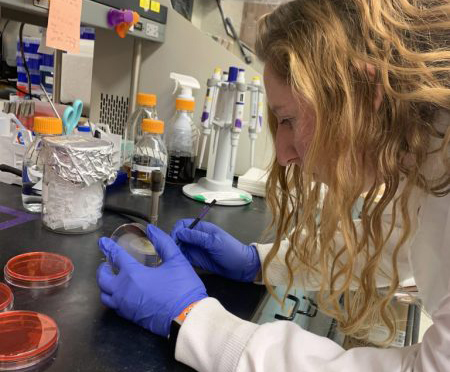
Salmonella can lurk anywhere, hiding in slightly undercooked chicken, within the raw eggs mixed into cookie dough and even in the feces of pet turtles.
A team of researchers at the University of Florida’s Institute of Food and Agricultural Sciences has created a vaccine that protects against non-typhoidal strains of salmonella. The vaccine has shown promise in preclinical trials on mice.
For vulnerable groups such as children under 5 and the elderly, salmonella can be deadly. According to the U.S. Centers for Disease Control and Prevention, 420 people die and 26,5000 are hospitalized in the United States because of salmonella each year.
“(Salmonella is) a bacteria and the infections occur through contaminated food and water. It can be spread also through fecal contamination or poor hygiene or improper food handling,” said Mariola Ferraro, a UF associate professor that specializes in infectious diseases and host pathogen interactions.
Most infections include diarrhea, fever and stomach cramps. Raw meat, eggs, fruits, vegetables and animals contaminated with bacteria, particularly reptiles, could pass on salmonella. Two active outbreaks of salmonella are currently linked to cucumbers and bearded dragons.
“I wouldn’t go out and caress or kiss your backyard chickens because they can be infected with bird flu nowadays or with salmonella,” said Anthony Maurelli, a UF environmental and global health professor.
UF’s vaccine was tested using salmonella extracted from raw sewage found in Gainesville, Florida, as opposed to previous salmonella research that focused on old laboratory strains. The research continues the legacy of Lisa Emerson, the first author of the study, who died unexpectedly from natural causes in September 2024 at the age of 29.
“The question that Lisa was asking was ‘How good is this vaccine against strains which are circulating in the real world in Gainesville in the 21st century?’” Maurelli said. “How well does that laboratory version of the strain relate to real-world strains that are out there circulating and making people sick?”
The salmonella used in the vaccine was shed from the feces of infected people, and despite the many microbes present in the wastewater, Emerson was able to culture the strain. Microbiologists use specialized ways to grow certain bacteria, a concept called selective media. The wastewater was placed in enrichment broth to grow the salmonella and was transferred to Petri dishes with media that killed off extraneous bacteria.
The concept of the salmonella vaccine began in 2015, with research making strides in the last five years. Traditional vaccines contain a live or attenuated strain of bacteria that injects the body with foreign material. However, the salmonella vaccine is cell-free.

“I feel like a lot of people are scared or afraid because they’re like, ‘I’m injecting a pathogen in my body that can then mutate and survive.’ In our case, there is no live salmonella bacteria that is going in your body,” said Saloni Bhimani, a UF doctoral student studying microbiology and cell science. Bhimani is a second author of the study.
Emerson worked alongside Andrew Rainey, and the two PhD students were a part of UF’s Clinical Translational Science Institute pre-doctoral training program, which brings multidisciplinary laboratory discoveries into real-world applications. Ferraro was Emerson’s mentor.
Emerson, an author of 12 studies, had recently become a post-doctoral fellow at the CDC in Atlanta before she died.
“She has this legacy as a researcher because she really cared about the public health. She wasn’t just doing this to build a career, become famous or anything like that. She actually wanted to make a difference,” Ferraro said.
Emerson enjoyed volunteering at animal shelters and bringing her puppy to Depot Park in Gainesville to support her fellow researchers as they participated in a weekly 5K run. A memorial scholarship at UF has been created in her honor.
“She was also really funny and she continues to inspire students here. We talk about her a lot still,” Ferraro said.
Originally Published:





